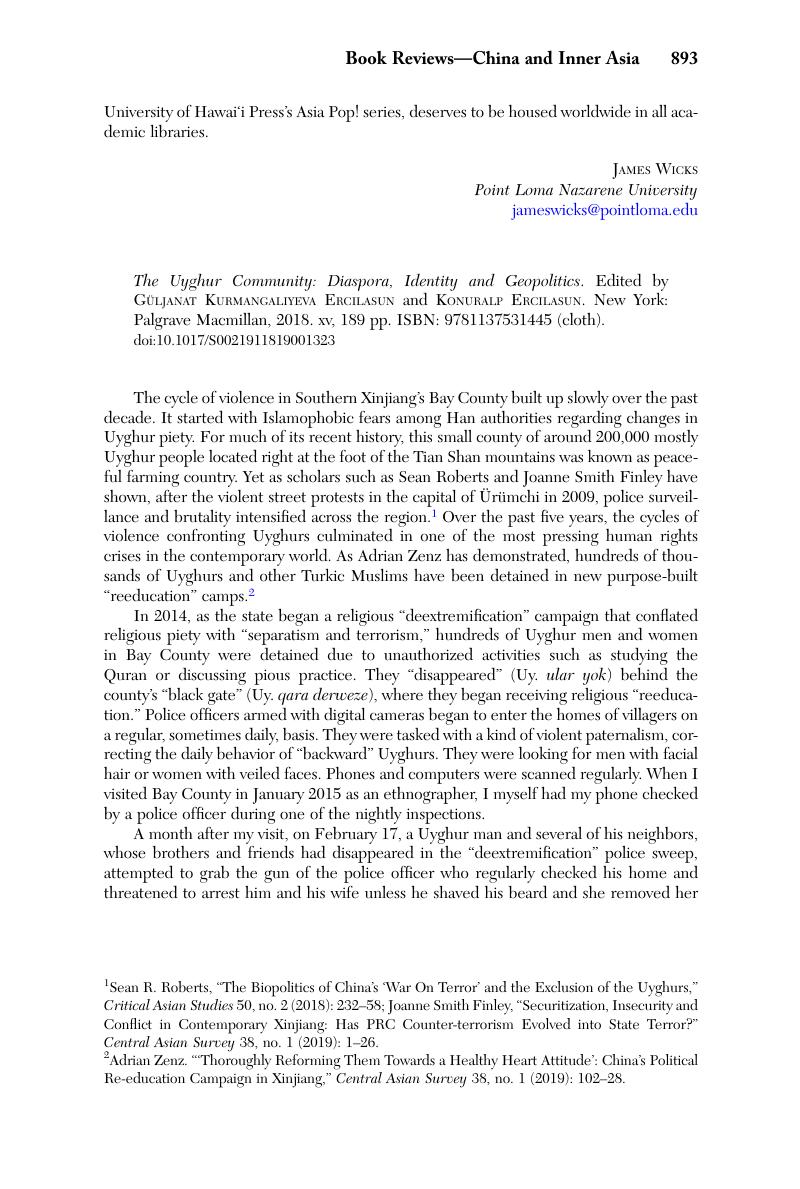No CrossRef data available.
Article contents
The Uyghur Community: Diaspora, Identity and Geopolitics. Edited by Güljanat Kurmangaliyeva Ercilasun and Konuralp Ercilasun. New York: Palgrave Macmillan, 2018. xv, 189 pp. ISBN: 9781137531445 (cloth).
Review products
Published online by Cambridge University Press: 03 December 2019
Abstract

- Type
- Book Reviews—China and Inner Asia
- Information
- Copyright
- Copyright © The Association for Asian Studies, Inc. 2019
References
1 Roberts, Sean R., “The Biopolitics of China's ‘War On Terror’ and the Exclusion of the Uyghurs,” Critical Asian Studies 50, no. 2 (2018): 232–58CrossRefGoogle Scholar; Finley, Joanne Smith, “Securitization, Insecurity and Conflict in Contemporary Xinjiang: Has PRC Counter-terrorism Evolved into State Terror?” Central Asian Survey 38, no. 1 (2019): 1–26CrossRefGoogle Scholar.
2 Zenz., Adrian “‘Thoroughly Reforming Them Towards a Healthy Heart Attitude’: China's Political Re-education Campaign in Xinjiang,” Central Asian Survey 38, no. 1 (2019): 102–28CrossRefGoogle Scholar.
3 Paul Eckert, trans. Mamatjan Juma, “Hacking, Shooting Incident Leaves 17 Dead in Xinjiang's Aksu Prefecture,” Radio Free Asia, February 20, 2015, https://www.rfa.org/english/news/uyghur/aksu-02202015214715.html (accessed August 4, 2019).
4 Nectar Gan and Andrea Chen, “Flamethrower Used to Flush Out Militants in China's Xinjiang Region, Says State Media,” South China Morning Post, November 23, 2015, https://www.scmp.com/news/china/diplomacy-defence/article/1881961/flamethrower-used-flush-out-militants-chinas-xinjiang (accessed August 4, 2019).
5 Ibid.
6 Ursula Gauthier, “Après les attentats, la solidarité de la Chine n'est pas sans arrière-pensées” [After the attacks, China's solidarity is not without ulterior motives], L'Obs le Magazine, November 18, 2015, https://www.nouvelobs.com/attentats-terroristes-a-paris/20151117.OBS9681/apres-les-attentats-la-solidarite-de-la-chine-n-est-pas-sans-arriere-pensees.html (accessed August 4, 2019).
7 Global Times Editorial Board, “L'Obs’ China Articles Biased, Unprofessional,” Global Times, December 26, 2015, http://www.globaltimes.cn/content/960651.shtml (accessed August 4, 2019).
8 Andrew Nathan, Harold Tanner, Vincent Wei-cheng Wang, Colin Mackerras, Lucien Ellington, and Kerry Brown, “What Some Watchers of China Think about the Case of Ursula Gauthier,” Matisak's Blog (A Stamp on the World), December 29, 2015, https://matisak.wordpress.com/2015/12/29/what-some-watchers-of-china-think-about-the-case-of-ursula-gauthier (accessed August 4, 2019).
9 See, for example, Coulthard, Glen Sean, Red Skin, White Masks: Rejecting the Colonial Politics of Recognition (Minneapolis: University of Minnesota Press, 2014)CrossRefGoogle Scholar.
10 Bhabha, Homi K., The Location of Culture (London: Routledge, 1994)Google Scholar.
11 See “Xi Jinping ganxie de Makelin shi shei?” [Who is the Makelin that Xi Jinping thanked?], China Renmin University Press, November 18, 2014, http://www.crup.com.cn/XXGL/01/2014/11/18/170153127501.html (accessed August 4, 2019).
12 Rachel Harris, Guangtian Ha, and Maria Jaschok, eds., Ethnographies of Islam in China (Honolulu: University of Hawai‘i Press, forthcoming).
13 The Baren Incident was an armed uprising involving around two hundred Uyghurs in the Kashgar region. The organizers of the uprising utilized religious rhetoric in opposition to the perceived threats of Han migration and new family planning regulations. See Millward, James, Violent Separatism in Xinjiang: A Critical Assessment (Washington, D.C.: East-West Center, 2004), 14–15Google Scholar.
14 Roberts, Sean R., “The Narrative of Uyghur Terrorism and the Self-Fulfilling Prophecy of Uyghur Militancy,” in Terrorism and Counter-terrorism in China: Domestic and Foreign Policy Dimensions, ed. Clarke, Michael E. (New York: Oxford University Press, 2018), 99–127CrossRefGoogle Scholar.
15 Bovingdon, Gardner, The Uyghurs: Strangers in Their Own Land (New York: Columbia University Press, 2010)Google Scholar; Finley, Joanne Smith, The Art of Symbolic Resistance: Uyghur Identities and Uyghur-Han Relations in Contemporary Xinjiang (Leiden: Brill, 2013)CrossRefGoogle Scholar.
16 James Leibold, “Toward a Second Generation of Ethnic Policies?” China Brief, July 6, 2012, https://jamestown.org/program/toward-a-second-generation-of-ethnic-policies/ (accessed August 4, 2019); Ma Rong, “21 shijie de Zhongguo shifou cunzai guojia fenlie de fengxian?” [Is there a risk that China could fracture in the 21st century?], Lingdaozhe 38–39 (2011); Angang, Hu and Lianhe, Hu, “Dierdai Minzu zhengce: Cuijin Minzu jiaorong yiti he fanrong” [Second-generation Minzu policies: Promoting organic ethnic blending and prosperity], Xinjiang shifan daxue xuebao (Zhexue shehui kexue bao) 32, no. 5 (2011): 1–13Google Scholar.
17 Thum, Rian, The Sacred Routes of Uyghur History (Cambridge, Mass.: Harvard University Press, 2014)CrossRefGoogle Scholar.
18 See also Shohret Hoshur, trans. Brooks Boliek, “Under the Guise of Public Safety, China Demolishes Thousands of Mosques,” Radio Free Asia, December 19, 2016, https://www.rfa.org/english/news/uyghur/udner-the-guise-of-public-safety-12192016140127.html (accessed August 4, 2019).


